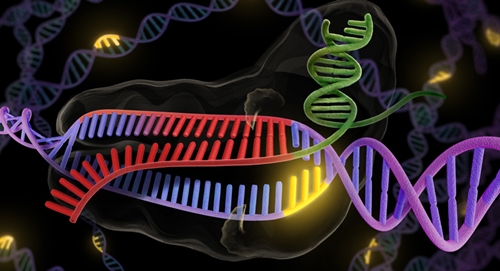
Artist depiction of Cas9 protein editing a gene (Jennifer Doudna, University of California – Berkeley)
18 May 2015. National Academy of Sciences and Institute of Medicine plan to write guidelines governing an emerging technology for editing human genomes. The initiative includes an international meeting in the fall to discuss the scientific, ethical, and policy issues associated with the technology known as CRISPR-Cas9.
CRISPR, short for clustered, regularly interspaced short palindromic repeats is adapted from a natural process used by bacteria to protect against attack by viruses, where a protein that deactivates or replaces genes binds to targeted RNA molecules generated by the genome. The RNA molecules then guide the editing protein, known as CRISPR-associated protein 9 or Cas9, to specific genes needing changes.
CRISPR-Cas9 techniques are becoming more efficient, widespread, and relatively easy to implement, raising concerns about their being applied to select desired traits in human embryos. In April 2015, a research team at Sun Yat-sen University in Guangzhou, China published a report of their attempts to modify a gene in human embryos rejected for in vitro fertilization.
The gene in this case causes the inherited blood disorder beta thalassemia that reduces production of hemoglobin, and the research team reported minimal success editing the problem gene. While the team concluded the technique was not ready for clinical use, reports of the experiments increased the urgency of calls for the establishment of guidelines before research with CRISPR-Cas9 goes much farther.
Among the calls for guidelines in the clinical use of CRISPR-Cas9 is a commentary published online in the journal Science on 19 March by 18 researchers in the field urging restraint in its application because of the potential for grave unintended consequences. The authors reported on discussions at a meeting of stakeholders in January 2015 held in Napa, California on medical, ethical, and legal implications of the research. Among the more urgent concerns raised by the group are modifications to genes in sperm and egg cells, known as germline cells, that are passed on to children.
The commentary’s authors include Jennifer Doudna, a molecular biologist at University of California in Berkeley and George Church, a geneticist at Harvard University, despite being on opposite sides of an intellectual property dispute over the technology. Both Doudna and Church founded businesses to commercialize their discoveries — Caribou Biosciences and Editas Medicine respectively — which are contesting the technology’s invention history and thus rights to patent the invention.
National Academy of Science and Institute of Medicine — scheduled to become National Academy of Medicine on 1 July — plan to apply their experience with a similar conference held in Asilomar, California in 1975 to develop rules for recombinant DNA research. No date for the meeting has yet been announced.
In addition to the summit meeting, the academies plan to appoint an international committee to explore the science of human gene editing, as well as get a better understanding of its clinical, ethical, legal, and social implications. An advisory group to guide the initiative is expected to be announced soon.
Read more:
- Gene Editing Harnessed to ID Cancer Targets
- Plant Science Biotech Gets Genome Editing Technology
- University Breeds Genome-Edited Pigs
- Genome Editing Shown to Repair Sickle Cell Gene
- Novartis Licensing Biotechs’ Gene-Editing Technologies
* * *

 RSS - Posts
RSS - Posts
[…] National Academies to Develop Gene-Editing Guidelines […]